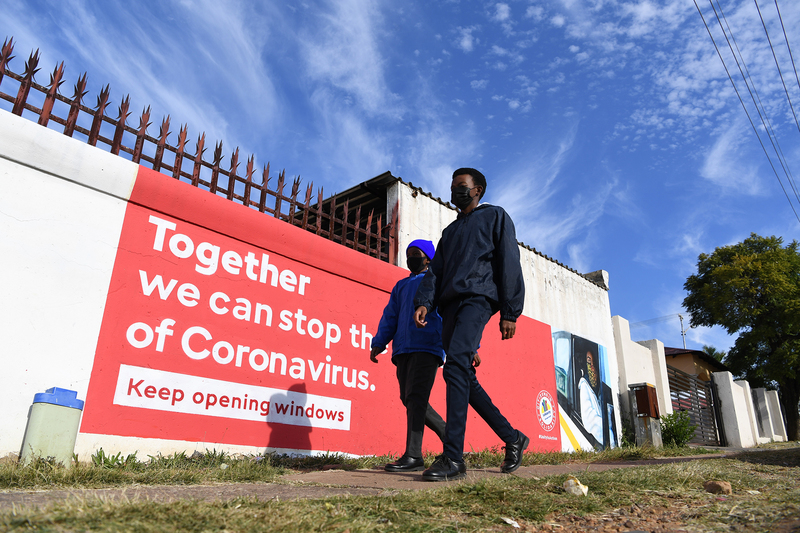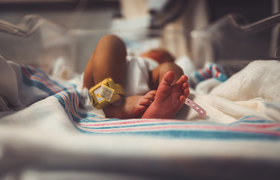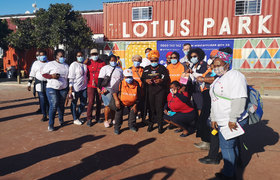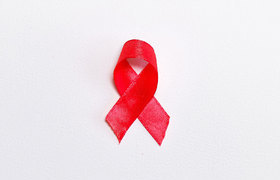It’s time to put children first – from response to recovery
04 August 2021 | Story Supplied. Photo Lefty Shivambu / Gallo Images. Read time >10 min.
The Children’s Institute (CI) at the University of Cape Town (UCT) has developed a series of advocacy briefs in collaboration with the Children’s Hospital Trust and the Michael & Susan Dell Foundation, calling for government to put children at the heart of South Africa’s COVID‑19 response and recovery plans.
The briefs document the impact of the pandemic on children and children’s services, and identify opportunities to strengthen systems, improve outcomes and better support children in future waves and crises.
Series editor, Lori Lake of the CI, described how children are particularly vulnerable to both the immediate shock and enduring impacts of COVID‑19: “This is especially the case during sensitive and rapid periods of development such as the first 1 000 days of life [from conception to a child’s second birthday] and adolescence when exposure to hunger, violence and adversity gives rise to toxic stress, which can cause long-term and irreparable harm to children’s immune systems, their developing brains and education and employment prospects”.
“Shocks such as climate change and COVID‑19 also tend to intensify existing inequalities.”
Co‑editor, Associate Professor Maylene Shung-King of UCT’s School of Public Health, said: “Shocks such as climate change and COVID‑19 also tend to intensify existing inequalities. For a privileged few, the pandemic simply meant a change in lifestyle, but for the majority of South Africans, the pandemic has been catastrophic with families facing unemployment, hunger, violence and an uncertain future.”
COVID-19 care
The researchers used the Western Cape as an illustrative case; in part because it was possible to access administrative data. It is an example of a ‘good’ case scenario in that it is a relatively well‑resourced province, and yet even in the Western Cape children’s needs were initially overlooked.
Children in the Western Cape were relatively better off than children in other provinces before the pandemic. Nine out of 10 children had access to healthcare and basic services and lived in households where someone was employed in 2018. Yet, their relative advantage masks significant inequalities – one in four children in the province lived below the poverty line, one in 10 children in food-insecure households, and one in six children in informal housing where overcrowding and poor water and sanitation increased their vulnerability to infection. COVID-19 has cut deep along these fault lines.
“Overtime, child health specialists succeeded in advocating for a more child‑centred approach.”
In the first year of the pandemic there were over 284 000 cases of COVID‑19 in the Western Cape and just over 12 300 of these cases were children. 1 500 children were admitted to hospital and 59 children died of COVID‑19.
According to Dr Chris Scott of UCT’s Department of Paediatrics and Child Health: “The initial health systems’ response to COVID‑19 care focused on adults, who accounted for over 95% of cases in the Western Cape. Children’s needs were side‑lined, resources were diverted from paediatrics to adult COVID‑19 care, and concerns around infection prompted the separation of infants and children from much-needed family support. Yet, overtime, child health specialists succeeded in advocating for a more child‑centred approach to contact tracing and the care of children in hospital.”
While children accounted for only 4% of cases in the province and 0.5% of the deaths, thousands more children have been affected by the illness and death of family members. Over one million children around the world are estimated to have lost a primary caregiver from March 2020 to April 2021. Therefore, systems must be put in place to identify children in need of care and protection when adults are admitted into hospital.
Routine healthcare services
Dr Jaco Murray, a paediatrician at Paarl Hospital, explained that because of the focus on adult COVID-19 care, and efforts to prevent infection, there was a significant drop in the coverage of essential child health services, with a 23% decline in young children’s visits to primary healthcare services. This has led to gaps in screening and treating children for HIV, TB and acute malnutrition, and will have a profound impact on children’s health and development for years to come.
As hospitals prepared for the first wave of COVID-19, paediatric and adolescent beds were re‑allocated to adult COVID‑19 care, elective surgeries were cancelled, and many children with disabilities were unable to access care. Over the year, hospital admissions for diarrhoea and pneumonia decreased, (perhaps due to mask‑wearing, handwashing and social distancing), yet the in‑hospital mortality rate increased, raising concerns that parents’ fears of contracting COVID‑19 were leading to life‑threatening delays in seeking medical care.
Concerted efforts by child health practitioners and community health workers helped ensure that some of these services were fully restored – with measles immunisation recovering to 95% (a 5% increase in coverage in 2019). However, it will require time, ongoing advocacy and proactive decision‑making to address the significant and potentially life‑threatening backlogs in elective surgeries.
Nutrition and food security
“Rising unemployment and food prices increased pressure on poor households, with 47% of households running out of money to buy food during hard lockdown,” said Professor Michael Hendricks from the Department of Paediatrics and Child Health.
“Despite families’ efforts to shield their children, child hunger has remained high, with one in seven households reporting that a child went hungry in April 2021. At the same time, the disruption of routine health services made it harder to identify and support children at risk of malnutrition.”
“There are worries of an increase in child malnutrition.”
The national disaster relief package rolled out from May 2020 offered some protection for children, but hunger levels increased again when the grant top‑ups and caregiver grants were withdrawn in October.
In addition, Dr Katharine Hall, CI senior researcher, warned that the decrease in the real value of the Child Support Grant (valued at R460 a month or R15 a day in April 2021) is likely to intensify child hunger in the coming months as the cost of food continues to rise and the buying power of this small grant is eroded.
“There are worries of an increase in child malnutrition,” she said.
Violence and injury
Early in the pandemic, child rights activists raised concerns about how rising unemployment, food insecurity and the stresses of lockdown would increase the risk of violence and injury in the home.
“Despite these projections, there was a 10% decrease in children admitted to the trauma unit for non‑accidental injuries – such as sexual abuse, physical abuse and gun violence. This was primarily driven by a sharp 50% decrease at the time of hard lockdown and the alcohol ban, yet cases returned to pre‑COVID levels by September 2020 when lockdown measures eased,” said Carla Brown, head of the Social Work Department at Red Cross War Memorial Children’s Hospital.
Professor Shanaaz Mathews, CI director, cautioned that “these figures do not necessarily represent a real decline in violence and maltreatment”.
“Instead, they are more likely to reflect the difficulties women and children faced in trying to access healthcare and other support services during hard lockdown. It is therefore essential to put proactive measures in place to identify and support women and children who experience interpersonal violence during pandemics and similar crises.”
Mental health and wellbeing
There have been very few studies on how the pandemic has impacted children’s mental health yet, based on previous humanitarian crises, COVID‑19 is likely to trigger a dramatic increase in depression, anxiety and post‑traumatic stress disorder in both children and their caregivers.
“Most children have been exposed to some form of loss – loss of school, loss of friends, or the loss of loved ones.”
According to Professor Mark Tomlinson, co-director of the Institute for Life Course Health Research at Stellenbosch University, women have been particularly hard hit by unemployment, food insecurity, domestic violence and an increased burden of childcare, and these additional pressures compromise their mental health and that of their children.
“In addition, most children have been exposed to some form of loss – loss of school, loss of friends, or the loss of loved ones – and they need support to cope with grief.”
Specialised child and adolescent mental health services remain extremely limited in South Africa. Greater efforts are therefore needed to build the capacity of families and frontline workers in schools, early childhood development (ECD) programmes and healthcare services to help children cope with loss and adversity.
ECD programmes
ECD programmes perform an invaluable service to society and have the potential to support young children and their families in times of crisis by enabling caregivers to seek employment, and ensuring that young children receive safe care, good nutrition, and early learning. Yet, Lizette Berry, senior researcher at the CI, argued that even before COVID‑19, the ECD sector in South Africa was fragile and underfunded.
“The mandatory closure of ECD programmes in 2020 intensified existing challenges. Prolonged lockdown, limited state support and the withdrawal of the ECD subsidy in most provinces led to the permanent closure of many ECD programmes and significant job losses. And this will cause not only immediate but also long‑term harm to the health, nutrition and education of young children.”
Nodes of care and support
The opening and closing of schools during the COVID‑19 pandemic have been highly contested as the education department seeks to minimise the disruption to children’s education while keeping children, educators and the broader school community as safe as possible.
Fewer than 1% of learners (1 200) contracted COVID‑19 in the Western Cape in 2020, and 3 900 learners required quarantine, mainly from community‑acquired infections. Yet, despite these relatively small numbers, widespread fears prevailed about learner and educator safety, resulting in repeated school closures.
“The school closures have had a devastating impact on education, with the majority of primary school children losing close to a full year of learning and an estimated 750 000 learners dropping out of school,” said Dr Patti Silbert, project manager of the Schools Improvement Initiative in the Schools Development Unit at UCT.
“Closures also prevented children from accessing an important source of nutrition, healthcare and psychosocial support, with over nine million learners losing out on a daily school meal during lockdown.”
The full set of advocacy briefs are available on the Children’s Institute website, as well as the researchers’ seven principles to guide a child‑centred response to COVID‑19.
 This work is licensed under a Creative Commons Attribution-NoDerivatives 4.0 International License.
This work is licensed under a Creative Commons Attribution-NoDerivatives 4.0 International License.
Please view the republishing articles page for more information.










